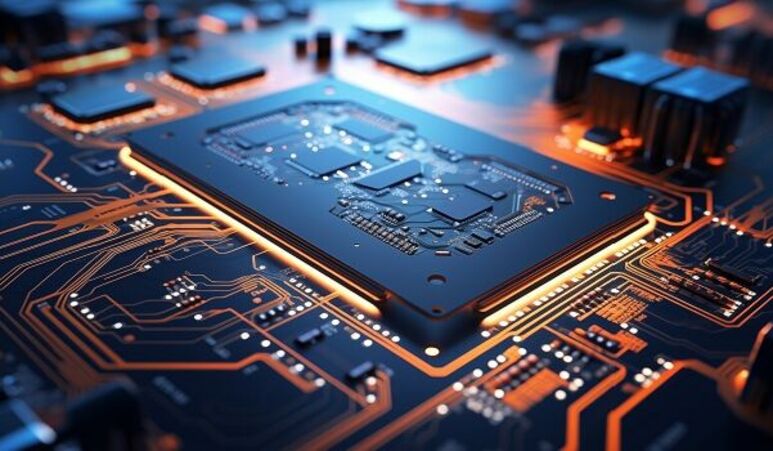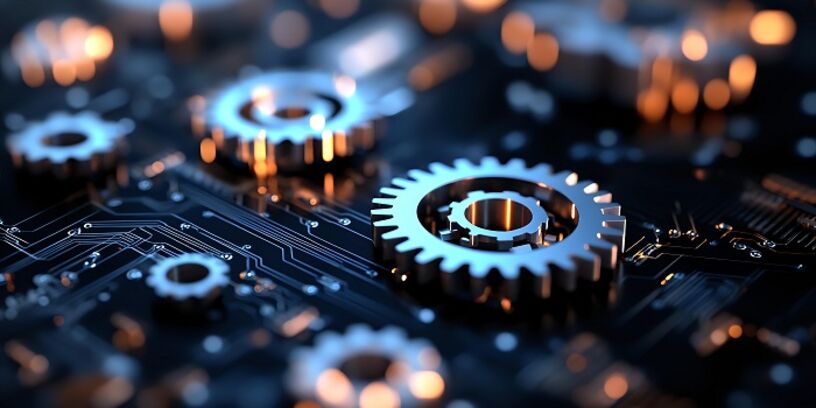The world's leading research and innovation centre for nanoelectronics and digital technologies, imec, together with the state of Baden-Württemberg, announced the establishment of the Advanced Chip Design Accelerator (ACDA) at the Hannover Messe. The new imec competence centre in Baden-Württemberg will develop state-of-the-art technologies in the fields of chiplets, packaging, system integration, sensor technology and (edge) artificial intelligence as part of the imec Automotive Chiplet Program (ACP). But what exactly does this mean for SMEs in the state?
More about imec
The imec (Interuniversity Microelectronics Centre) is one of the world's leading research and innovation centres in the field of nanoelectronics, microchip technologies and digital systems. Founded in 1984 in Leuven, Belgium, imec now collaborates with over 600 industrial partners and academic institutions worldwide, including major technology companies such as Intel, ASML, TSMC, Samsung, Bosch and Infineon. The aim of the institute is to close the gap between basic research and industrial application. It develops new semiconductor, sensor and system technologies and transforms these into market-ready solutions together with partners. At the centre of this is the vision of creating ever smaller, more powerful, more energy-efficient and more intelligent chips that can be used in almost all future industries - from artificial intelligence and mobility to energy and medical technology.
The most important fields of research at imec include semiconductor and nanoelectronics, where work is being carried out on the next generation of chips beyond traditional silicon technologies. The researchers are developing transistors in the 2-nanometre class, 3D integration methods and innovative materials to increase computing power and reduce energy consumption. Another focus is on so-called chiplets, modular components that can be combined to form complex systems. This technology enables customised, scalable and cost-efficient chips, particularly for applications in the automotive industry and in AI systems. The new imec competence centre in Heilbronn, the Advanced Chip Design Accelerator (ACDA), which specialises in automotive chips and system integration, plays a central role in this. Other fields of research include sensor technology and photonics, for example in applications in the healthcare sector. Sustainability and the development of environmentally friendly "green chips" are also playing a growing role.
With the new competence centre in Heilbronn, imec is further expanding its international presence and at the same time strengthening Baden-Württemberg's position as a leading region for microelectronics and vehicle technology. In close cooperation with car manufacturers, suppliers and research institutions, the centre will open up new avenues for the development of chiplets, sensors and AI systems in the automotive sector.
What exactly can chiplets do?
Chiplets are modular components of a microchip, each of which fulfils a clearly defined function - such as computing logic, memory, signal processing or sensor control.
In contrast to a classic monolithic chip, in which all functions are integrated on a single piece of silicon, chiplet systems combine several specialised sub-chips.
These chiplets are connected to each other via standardised high-speed interfaces - such as the open standard UCIe (Universal Chiplet Interconnect Express).
The result is a so-called multi-chip module or "system-in-package", in which the individual chiplets interact like building blocks in a 3D puzzle.
The great advantage of this architecture lies in its flexibility and efficiency:
Instead of designing a completely new, large chip each time, companies can reuse, adapt or recombine existing chiplets to develop customised solutions for different products. This reduces development costs, shortens time-to-market and allows specialised applications - such as for automotive, robotics, medical technology or Industry 4.0 - to be implemented more quickly and sustainably.
Technologically, the approach also makes it possible to combine different manufacturing processes and materials in one system: a computing chiplet, for example, can be manufactured using state-of-the-art 3-nanometre technology, while an analogue or sensor chiplet is produced using an older, more cost-effective process. This creates a powerful, modular and scalable chip architecture that can be adapted to specific requirements - similar to how software is built from modules.
Fields of application for new chip technologies
Even though the automotive industry is a key focus for the development of chiplets, the technology has great potential for numerous other fields of application. The most important of these include
Industry 4.0 and mechanical engineering
Baden-Württemberg is one of the leading mechanical engineering regions in Europe. Research into intelligent sensor systems, energy-efficient chips and edge AI can be used directly here - for example in predictive maintenance, robotics, production automation and digital quality control. Robust, locally networked chip systems can make machines smarter, more autonomous and more reliable without the need to constantly transfer data to the cloud.Energy, environment and sustainability
In areas such as smart grids, energy management and sustainable production, imec offers expertise in high-performance sensor technology and energy monitoring systems.
Nanoelectronic components and AI-supported control systems make it possible to precisely measure energy flows, reduce losses and integrate renewable energies more efficiently. In the field of battery research - a key topic for electromobility, energy storage and grid infrastructure - new materials and nanoscale production techniques are also currently being developed to improve cell performance and service life.Health, medical technology and biotechnology
With centres such as Tübingen, Mannheim and Heidelberg, Baden-Württemberg is a hotspot for medical research and biotechnology. Developments in bioelectronic sensors, lab-on-a-chip systems and portable diagnostics can have a major impact. Such technologies enable, for example, continuous health monitoring, molecular diagnostics and personalised medicine - key topics in an ageing society and for a sustainable healthcare industry.Mobility of the future (beyond the car)
Beyond the classic automobile, new chip technologies can also be transferred to aviation, rail transport and urban mobility systems. There, networked sensors, energy-efficient control chips and AI-based safety mechanisms are needed to enable autonomous, safe and sustainable transport solutions.Artificial intelligence, data processing and microelectronics
AI research and the data economy also benefit. Specialised chips for AI calculations that process data decentrally and securely are crucial for areas such as data protection, cloud-independent applications and industrial AI. This allows companies to develop their own, sovereign hardware solutions instead of being dependent on non-European processors.- Smart cities and infrastructure
This includes, in particular, energy self-sufficient sensors that can measure and optimise traffic flows, air quality or energy consumption in real time. Such systems are relevant for sustainable urban planning, environmental protection and mobility management.
How companies can actively benefit from chiplets
In order for companies to really utilise chiplet technologies - whether in the automotive sector or in other industrial fields - strategic, technological and partnership-based steps are required.
1. Build technology understanding and design expertise
Companies should develop a deep understanding of the architectural principles and design tools of chiplet systems. This includes knowledge of interconnect standards such as UCIe, packaging methods (e. g. 2.5D or 3D integration) and design software for modular systems. These competences can be developed in a targeted manner through training courses, cooperation with imec or other research institutions and pilot projects.
2. Identify application scenarios
The best way to get started is for companies to define specific fields of application in which chiplets create clear added value, such as AI acceleration and data processing at the edge of the network (edge computing), highly integrated sensor systems for machines, vehicles or medical devices, control systems with low energy consumption or secure, modular electronic architectures for industrial plants. This makes it possible to specifically analyse which combination of chiplets offers the greatest benefit.
3. Entering into research and development partnerships
As chiplet designs are highly complex, companies benefit greatly from co-operations.
In Baden-Württemberg, cooperation with the imec Competence Centre in Heilbronn (ACDA), which specialises in automotive chiplets, sensor integration and edge AI, is particularly suitable. Partnerships with Fraunhofer Institutes, universities or Cyber Valley can also help to transfer the latest research findings into in-house product developments at an early stage.
4. Expand packaging and testing expertise
The actual innovation lever for chiplets lies in packaging, i. e. the way in which individual components are physically connected to each other. Companies that invest in advanced packaging processes - such as interposer technologies, through-silicon vias (TSVs) or thermally efficient connections - secure themselves a technological advantage. This expertise can be decisive in the future, particularly in sensor technology, mechanical engineering and power electronics.
5. Becoming part of the emerging chiplet ecosystem
The chiplet revolution is not an isolated phenomenon - it is based on a global, open ecosystem. Companies can position themselves at an early stage through memberships and active contributions to standardisation committees and alliances such as UCIe, BOWI or IPCEI Microelectronics. This gives them access to development platforms, reference designs and supply chains that are otherwise reserved for large corporations.
6. Thinking of new business models
Chiplets also open up new economic perspectives. Instead of manufacturing complete chips, companies can develop their own specialised chiplets or IP components and license them to other providers or incorporate them into larger systems. This creates new value creation models, especially for SMEs that have unique expertise in sensor technology, power electronics or embedded systems.
7. Using funding programmes and innovation networks
The federal, state and EU governments actively promote projects in the fields of semiconductors, microelectronics and chip design. Programmes such as IPCEI Microelectronics II, the Innovation Campus Mobility of the Future (ICM) or the AI Innovation Park Heilbronn (IPAI) offer access to funding, research consortia and technology infrastructures. Those who get involved here early on not only benefit financially, but also become part of the European microelectronics strategy, which ensures long-term competitiveness.
Outlook
Chiplets mark the transition from classic, monolithic semiconductors to modular, customisable and sustainable system architectures. For companies in Baden-Württemberg, this means that those who invest early in expertise, cooperation and pilot projects can benefit from this development in many ways - technologically, economically and strategically. Whether in mechanical engineering, sensor technology, the energy sector, medical technology or industrial automation - chiplets create the basis for the next generation of intelligent, efficient and networked systems, and therefore for the industrial future of the state.


